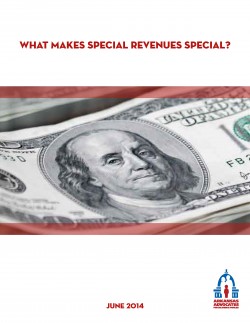
Special revenue collections are a major source of revenue for the Arkansas budget, totaling $1.8 billion in FY2013. However, they are often left out of the budget spotlight because the ways in which these funds are spent have already been determined.
A new report by AACF says the taxes that make up special revenues can be beneficial because they are more targeted than most other taxes (motorists pay a fuel tax, tourists pay a tourism tax, etc.), but warns these taxes can sometimes disproportionately affect low-income families.
It’s important to have an understanding of special revenues because they often represent billions of dollars that fly under the radar of the major budget discussions (which normally focus on general revenues). Special revenues are another way to provide funds for important programs like educational adequacy and the Highway Department fund.
The top five special revenue collection sources for FY2013:
- Sales Tax ($414 million). A 7/8 percent increase in the Sales Tax that Arkansans pay on everyday purchases goes to the Educational Adequacy Fund.
- Motor Fuels Tax (393 million). A 21.5 cent Motor Fuels tax is added to every gallon of gas pumped at Arkansas gas stations. Revenue from this tax is split between Cities (15 percent), Counties (15 percent), and the State Highway Department Fund (70 percent).
- Sales Tax – Property Tax Relief ($236 million). Another part of the sales tax that Arkansans pay on everyday purchases is for property tax relief. An additional ½ percent is added to the sales tax to benefit the Property Tax Relief Fund.
- Motor Vehicle License ($117 million) Taxes are applied to motor vehicle ($20) and motor scooter licenses ($9). Revenue from this tax is split between Cities (15 percent), Counties (15 percent), and the State Highway Department Fund (70 percent).
- Sales Tax – Conservation Tax ($64 million) The Conservation Tax adds 1/8 percent to the Arkansas Sales Tax. These revenues are split between the Game Protection Fund (45 percent), the Department of Parks and Tourism (45 percent), the Department of Heritage Fund Account (9 percent), and the Keep Arkansas Beautiful Account (1 percent).
The top five special revenue beneficiaries for FY2013:
- Total Highway and Transportation Department ($445 million). This fund also the State Highway Commission. It is used for maintenance and operations of over 1,200 bridges as well as over 100,000 miles of public roads in Arkansas.
- Educational Adequacy ($419 million). This fund promotes education reform in Arkansas schools for students in grades K-12.
- Property Tax Relief ($230 million). This fund is distributed to each county’s treasurer for property tax relief. The property tax relief fund allows an individual to claim up to $350 in a homestead credit on their annual real estate taxes.
- County Aid ($92 million). Seventy five percent of this fund is parceled out equally among Arkansas counties, while the remaining amount is distributed based on population size for “general county purposes.”
Municipal Aid ($84 million). The Municipal Aid fund receives money from general and special revenues. The special revenue funding comes from highway revenues and is subject to the Arkansas Highway Revenue Distribution Law.
